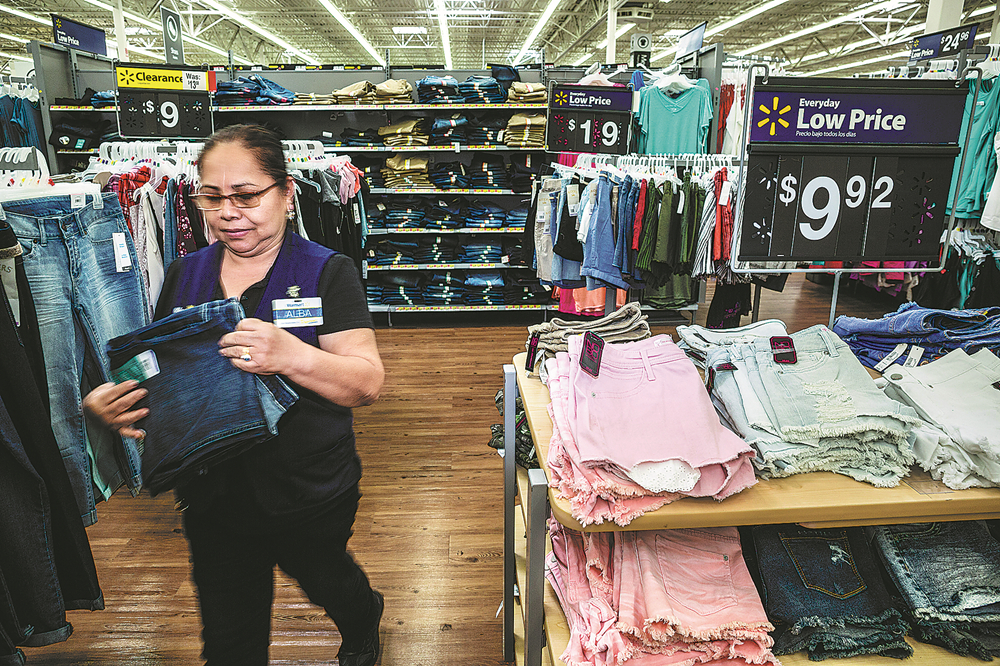An employee arranges clothing at a Walmart Inc store in Secaucus, New Jersey. Walmart is expected to be hit if a trade war starts. [Photo provided to China Daily]
The only thing for sure is loss of sales for some, gains for others, higher costs for many
It has been called a trade spat, a trade dispute, a trade confrontation, a looming trade war and even a trade bluff.
On Friday, unless there is some type of deal between Washington and Beijing, the rhetoric will become reality: a trade war.
The United States would impose 25 percent tariffs on $34 billion worth of Chinese machinery, medical instruments, aircraft parts and other goods. In return, China would impose the same tariff rate on the same value of US goods, mostly farm products and seafood.
Those directly or indirectly connected to the hundreds of products facing tariffs from the US and China — manufacturers, growers, middlemen, consumers and even other countries — would face the impact.
The only certainties from Friday would be loss of sales for some, sales gains for others and higher prices for many. The biggest uncertainty is what comes next.
US President Donald Trump has threatened more tariffs: 10 percent on an additional $200 billion of Chinese goods and then another $200 billion in tariffs for any further Chinese retaliation. He also said he is contemplating a 20 percent tariff on European autos.
China's Ministry of Commerce has said the Trump administration is capricious and has further inflamed trade provocations, forcing China to make a strong response.
China is fully prepared to take multiple measures to respond if the US comes up with a new tariff list to adopt trade-distorting practices, a ministry spokesman said.
The immediate impact is expected to be minimal for most businesses and consumers. But economists say the world eventually could be pushed into a recession by the combination of the June 1 steel and aluminum tariffs Trump imposed on Mexico, Canada and the European Union — the first two nations accounting for about half of US imported metals — and retaliatory tariffs, including Chinese tariffs.
But Daniel Rosen, partner at economic research firm Rhodium Group, told The New York Times: "Nobody can honestly claim in high confidence that they understand what the overall impact will be. You may as well project the weather on a Tuesday afternoon a year from now.''
For Stephanie Nadeau, owner of the Lobster Company in Arundel, Maine, the potential impact of a 25 percent tariff is clear. Some 70 percent of her lobster exports go to Asian markets, especially China.
China's US lobster imports increased from $108.3 million in 2016 to $142.4 million last year as an emerging middle class can now afford them.
"It is Maine lobstermen, the men and women on boats in Alaska, and families harvesting and processing seafood in the Pacific Northwest who will feel the brunt of the administration's misguided policy. It is not clear where these trade actions will ultimately lead; what is clear is that they will negatively impact American seafood jobs," John Connelly, president of the National Fisheries Institute, said in a statement to China Daily.
Businesses and industries across the US economy have been lobbying the White House to let up on tariffs for months, as have politicians of both main political parties, with little success.
And Trump has continued to sing his own praises for the tariffs.
At a groundbreaking ceremony for the new $10 billion Foxconn plant in Racine, Wisconsin, on Thursday, he said: "We've put tariffs on steel and aluminum. Those businesses are through the roof.''
Some US steelworkers, despite being the intended beneficiaries of the steel tariffs, may lose their jobs.
Novolipetsk Steel, in Mercer County, Pennsylvania, imports as much as two million tons of steel slabs annually. CEO Bob Miller has estimated that up to 1,200 jobs could be at risk. The company could also pull back from planned plant investments, including $600 million in Pennsylvania and Indiana alone.
A fisherman loads seafood into a tank on a boat in Texas. China's US seafood imports have increased rapidly as an emerging middle class can now afford them. [Photo provided to China Daily]
Businesses in Michigan are already feeling the impact of the steel and aluminum tariffs. Kent Ensing, vice-president of supply management at Zeeland, Michigan-based furniture manufacturer Herman Miller, said his company does not import raw steel or aluminum from Canada, Europe or Mexico, but has still felt the impact of the tariffs.
"US domestic mills raised their prices immediately after tariffs were announced," Ensing told the Holland Sentinel. "The current domestic prices are now equivalent to the imported prices with the tariffs."
Behlen Manufacturing Co in Columbus, Nebraska, is a global leader in steel fabrication, and now faces 30 to 40 percent higher domestic steel prices. Behlen does not use foreign steel but domestic prices rose after the tariffs were introduced, just as they did after March 2002 tariffs.
The Beer Institute — a trade group that represents beer manufacturers — said US brewers fill and sell about 36 billion aluminum cans and bottles per year. Aluminum cans are the single largest cost in US beer production, according to an analysis from economic research firm John Dunham & Associates.
The US beer industry creates 2.23 million US jobs, which is 1.4 percent of all the nation's employment, according to Dunham's analysis. The aluminum tariff will add an additional $347.7 million in costs for brewers and put more than 20,000 of those jobs at risk, he said.
In Texas, oil and gas operators and construction and manufacturing depend heavily on steel and aluminum from Europe, Mexico and Canada.
The new tariffs will only increase costs for those and other businesses, still reeling from price rises from duties Trump imposed earlier this year on steel and aluminum from China and most of the world's other suppliers.
Patrick Jankowksi, regional economist at the Greater Houston Partnership, a business advocacy group, said the tariffs could spur another round of cost-cutting and layoffs at Houston energy and manufacturing firms that many had hoped had ended.
The state of Minnesota said on Thursday that $641 million of its exports — from steel to pork to soybeans — would be affected by counter-tariffs from China, Canada, Mexico and the European Union. This comprises $265 million in products from Canada, $159 million from China, $150 million from the EU and $67 million from Mexico.
Wheatland Steel and Trim is a Tower City, North Dakota, company specializing in steel roofing. Moses Wipf, a manager with Wheatland, said farmers might want to build themselves a new barn, but the increased price of steel — and a lull in corn and soybean prices — might put this out of reach.
The Kansas City Federal Reserve released the results of its June manufacturing survey on Wednesday, which showed strong growth, but manufacturing executives are concerned that Trump's tariffs on steel and aluminum and Chinese products could drive up prices and disrupt business activity.
The Dallas Fed's manufacturing survey, released the day before, also contained concerns about the effects of Trump's tariffs.
"I can't believe the effect the tariff response has had on the metals trade," a fabricated-metal producer said in response to the Dallas survey. "Somebody needs their head examined if they think this is good for the American economy."
US agriculture will bear the brunt of the countermeasures to be imposed by China.
Soybean growers face a loss of 69 percent of Chinese sales, said Purdue University agricultural economist Wallace Tyner, who analyzed data for the US Soybean Export Council.
Soybean prices hit a nine-year low recently as China seeks to buy the crop from other countries.
US soybean exports to China total more than $12 billion annually. The loss of US sales comes because the retaliatory tariff will make US soybeans more expensive than those China can buy from other countries, principally Brazil.
Pork-producing states face retaliatory tariffs on certain products shipped to China because of Trump's tariffs. Mexico has said it will raise the tariff on certain US pork products from 10 percent to 20 percent on Thursday.
As Mexico — a prime buyer of pork — looks for alternative sources, Buhr said tariff-free Canadian and EU pork producers look to benefit at the expense of US hog farmers.
Robert Kudrle, an international trade professor at the University of Minnesota, said, "Whenever a buyer can easily substitute something cheaper for your product, your market goes down."
Whether the US public cares about farmers' suffering is anybody's guess, Tyner and Buhr said. But what may rouse consumers is the ripple effect of tariffs.
"Some people still talk about this as a stare-down" that will end with both sides finding a compromise, Duncanson said. "I'm not sure about that."
As Indiana, a steel- and aluminum-producing state, celebrated Trump's imposition of tariffs on imported metal, Tyner wrote a news release reminding his fellow residents that the state also is one of the largest producers of auto parts, and those materials were about to cost significantly more.
The same can be said of rising farm machinery costs in rural communities or any of the 300 frequently used boat parts facing the Chinese tariffs, said Nicole Vasilaros, senior vice-president at the National Marine Manufacturers Association. They cumulatively could mean a $2,000 price increase on 14- to 16-foot boats that generally cost in the low five figures.
The ripple effect may finally hit home when most people directly experience the costs of tariffs at the cash register, Kudrle said.
The US tried to limit the first list of Chinese products to be taxed to those that were not everyday purchases, Kudrle added.
"You can do that when you're putting tariffs on $34 billion or $50 billion worth of products," he said. With Trump's latest threat to add another $200 billion worth of Chinese products to the tariff list, Kudrle predicted, "It will be impossible."
Zhao Huanxin in Washington and Linda Deng in Seattle contributed to this story.

[NextPage]

Trade war threat casts shadow amid uncertainty
Editor:张焕勤
Source:China Daily
Updated:2018-07-03 11:15:55
Source:China Daily
Updated:2018-07-03 11:15:55
Special
Contact
Welcome to English Channel! Any suggestion, welcome.Tel:0731-82965627
lisl@rednet.cn
zhouqian@rednet.cn











